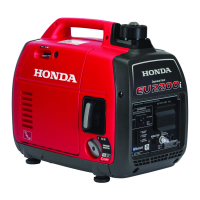
Do you have a question about the Honda EU2000i and is the answer not in the manual?
| Model | EU2000i |
|---|---|
| Type | Inverter |
| AC Output | 120V |
| Engine | Honda GX100 |
| Displacement | 98.5cc |
| Run Time at Rated Load | 3.4 hours |
| Run Time at 1/4 Load | 8.1 hours |
| Starting System | Recoil |
| Dry Weight | 45.6 lbs |
| Maximum AC Output | 2000W |
| Rated AC Output | 1600W |
| DC Output | 12V, 8A |
| Engine Type | 4-stroke, OHV, single cylinder |
| Fuel Tank Capacity | 0.95 gallons |
| Run Time per Tankful | 3.4 hrs @ rated load, 8.1 hrs @ 1/4 load |
| Noise Level | 53 to 59 dBA |
| Dimensions | 20.1" x 11.4" x 16.7" |
General safety guidelines and warnings for generator operation, covering hazards and operator responsibility.
Covers electric shock, fire/burn hazards, and refueling safety precautions.
Explains the purpose and location of safety labels on the generator for hazard warnings.
Illustrates and identifies the location of all major controls and features on the generator.
Details on Engine Switch, Starter Grip, Fuel Tank Vent Lever, and Choke Lever.
Explains Output, Overload, Oil Alert indicators and AC/DC circuit protectors.
Describes the Eco-Throttle system and Parallel Operation Outlets.
Guides on readiness checks, knowledge acquisition, and ensuring the generator is ready.
Essential safety rules for operating the generator, including ventilation and appliance connection.
Step-by-step instructions for starting the generator engine, including pre-start checks.
Procedures for safely stopping the generator engine during normal operation or emergencies.
Guidelines for connecting and operating AC appliances with the generator.
Instructions for connecting two EU2000i generators for parallel operation.
Procedures for using the generator's DC output for charging 12-volt batteries.
Information on how the Eco-Throttle system works to manage engine speed and fuel efficiency.
Information on connecting the generator for standby power to a building's electrical system.
Covers the importance, safety, and schedule for generator maintenance.
Detailed instructions and safety warnings for refueling and fuel recommendations.
Details on checking, changing, and recommended engine oil types.
Instructions for inspecting and servicing the generator's air cleaner.
Steps for inspecting, cleaning, gapping, and replacing the spark plug.
How to clean and service the spark arrester to ensure proper functioning.
Steps for preparing the generator for storage to ensure trouble-free operation upon reuse.
Steps for safely draining fuel from the carburetor and fuel tank for storage.
Instructions for changing the engine oil and lubricating the cylinder for storage.
Essential precautions for storing the generator to prevent hazards like vapor ignition.
Lists possible causes and corrections for the engine failing to start.
Identifies common reasons for reduced engine power and their solutions.
Troubleshooting guide for when the generator's AC outlets provide no power.
Shows where to find the generator's serial number for record-keeping and inquiries.
Information on modifying the carburetor for optimal performance at high altitudes.
Lists detailed technical specifications for the generator's dimensions, engine, and output.
Provides a schematic diagram illustrating the generator's electrical connections and components.
Instructions on how to find an authorized Honda servicing dealer.
Outlines the terms and conditions of the generator's limited warranty.
Details the warranty coverage for the engine's emission control system.
Instructions for filling the engine with the correct type and amount of oil before initial use.
Guidance on adding fuel to the generator, including safety precautions and fuel type recommendations.
Lists essential reading before use and encourages product registration.
